DOH Medicaid Update January 2004 Vol.19, No.1
Office of Medicaid Management
DOH Medicaid Update
January 2004 Vol.19, No.1
State of New York
George E. Pataki, Governor
Department of Health
Antonia C. Novello, M.D., M.P.H., Dr. P.H.
Commissioner
Medicaid Update
is a monthly publication of the
New York State Department of Health,
Office of Medicaid Management,
14th Floor, Room 1466,
Corning Tower, Albany,
New York 12237
Table of Contents
Gifts, Inducements And Remuneration
New Type Of Common Benefit Identification Card To Be Issued
New Enrollment Applications: Fee-for Service Providers
Synagis Procedure Code Correction For Physician Billing
Asthma Triggers
Information
For
Pharmacists
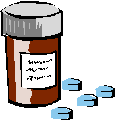
Automatic Refills
Return to Table of Contents
Automatic refilling of prescriptions/orders for prescription drugs, over-the-counter products, medical surgical supplies and enteral products is NOT allowed under the Medicaid program.
What is Allowed?
- Requests for a refill
- A recipient or designated caregiver may contact the pharmacy to request necessary refills.
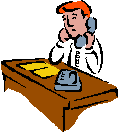
- Provider inquiry
- A provider may initiate contact with a recipient to determine if a refill is necessary. Documentation of the need for a refill shall be maintained in the patient record and must include the date and time of contact, recipient or designated caregiver's name and contactor's identification. This documentation must be available for audit purposes.
Reminder: Compliance with HIPAA privacy guidelines is mandatory.
If you have any questions regarding this policy, contact the Medicaid Pharmacy Policy and Operations staff at 518-486-3209.

GIFTS, INDUCEMENTS AND REMUNERATION
Return to Table of Contents
Can I offer a free cell phone or pager to Medicaid recipients in exchange for their patronage?
Can I advertise or use word of mouth promotion to advise Medicaid recipients that co-payments/co-insurance will be waived to solicit more business?
Can I accept manufacturer coupons for drugs from my Medicaid clientele and reimburse the recipient?

NO! NO! NO!
Under federal law, New York State Department of Health regulations and New York State Board of Regents rules (Part 29) involving unprofessional conduct, pharmacies and other providers cannot offer remuneration to a Medicaid beneficiary if the person knows or should know that the offer or transfer is likely to influence the beneficiary's selection of a provider of Medicaid items or services.
Remuneration can include waiver of co-payments/co-insurance, cash or cash equivalents, gifts such as cell phones, pagers and the transfer of items for free or for other than fair market value.
Violation of these laws and regulations could result in removal from participation in the Medicaid program and heavy civil monetary penalties (up to $10,000 for each wrongful act).
What are the actions I should take if I see this type of activity?
If you suspect that a provider has engaged in any of the activities listed above or any other questionable activity, please call the NYS Medicaid Fraud Hotline at (877) 87FRAUD. Your call will remain confidential.
More information regarding Medicaid Fraud and Abuse can be found at:
http://oig.hhs.gov/fraud/docs/alertsandbulletins/sabgiftsandinducements.pdf
Questions related to this article can be directed to the Division of Medicaid Fraud Control and Program Integrity at (518) 473-1984.
NEW TYPE OF COMMON BENEFIT IDENTIFICATION CARD TO BE ISSUED
Return to Table of Contents
Beginning in March 2004 the State will begin issuing a new type of Common Benefit Identification Card (CBIC) to New York State Medicaid recipients. Since the new Cards will be issued to Medicaid eligible individuals over the course of several months, please be aware that you may be presented with either type of Card when a Medicaid recipient requests medical services.
To insure that the Card presented by your Medicaid patient is currently valid, it is important to continue to verify Medicaid eligibility through the Medicaid Eligibility Verification System (MEVS) by using ePACES, VeriPhone or telephone dial up eligibility access. Medicaid enrolled providers can receive assistance with MEVS verification procedures or VeriPhone equipment by dialing (800) 943-9000.
Below are examples of both the current CBIC format and the new format. Note there are no changes to the front of the Card, which contains recipient identification information. There are minor changes to the back of the Card as depicted, below.
CBIC CARD (FRONT)
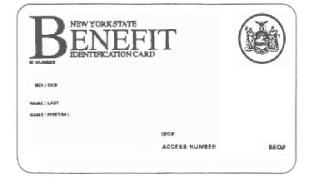
CURRENT CBIC CARD (BACK)
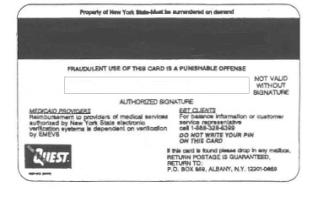
NEW CBIC CARD (BACK)
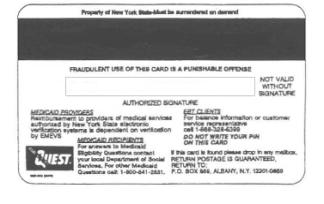
If you have any questions regarding this article, please call the Office of Medicaid Management Helpline at (800) 541-2831.

Time Saving
Information
FEE-FOR-SERVICE PROVIDERS
Revised Enrollment Applications Will Be The Only
Acceptable Forms
Return to Table of Contents
The Fee-for-Service Provider Enrollment Unit has revised all their provider enrollment applications. For enrollment processing, the revised applications will be the only accepted forms. Failure to submit the revised application for a fee-for-service provider will result in the application being returned and will cause a delay in the enrollment process.
To obtain copies of the revised application forms, please call the Fee-for-Service Provider Enrollment Unit at (518) 486-9440 or write to:
Office of Medicaid Management
Fee-for-Service Provider Enrollment
150 Broadway, Suite 6E
Albany, NY 12204-2736
SYNAGIS PROCEDURE CODE CORRECTION FOR PHYSICIAN BILLING
Return to Table of Contents
The November 2003 Medicaid Update contained an article on the Coverage of Palivizumab (Synagis). The practitioner billing instructions advised physicians to use code 90379 (respiratory syncytial virus immune globulin) when billing for the cost and administration of palivizumab. The correct code to use is 90749 (unlisted immunization procedure), with a copy of the invoice attached to the claim. Insert the acquisition cost plus a two-dollar ($2.00) administration fee in the "amount charged" field on the claim form.
For more information on practitioner billing, see the MMIS Physician Provider Manual page 7-105 (7/1/03).
PATIENT EDUCATIONAL TOOLS
Return to Table of Contents

This month's patient educational tools features an article on "Asthma Triggers".
The Medicaid program encourages practitioners to copy and distribute the following information to their patients and to share them with their colleagues.
Asthma Triggers
If you have asthma, your airways are very sensitive. They may react to things called triggers. Triggers are factors that make your asthma worse or keep your asthma from getting better. Every person has his or her own triggers. In order to control your asthma it is important that you identify which triggers you are sensitive to. Once you have identified the triggers that make your asthma worse, you can take steps to reduce your exposure to your asthma triggers.
ANIMAL DANDER
Animal dander or flakes in the skin, hair or feathers of all warm-blooded pets including dogs, cats, birds and rodents are asthma triggers. There is no such thing as an allergen-free pet. The length of a pet's hair does not matter. The allergen is in the saliva, urine and dander.
STEPS TO TAKE TO CUT DOWN YOUR RISK OF HAVING AN ASTHMA ATTACK FROM ANIMALS
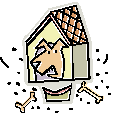
- Do not have pets or leave them outside if you do have pets.
- Do not let pets into the bedroom of a person who has asthma.
- Keep the door closed to the bedroom of the person who has asthma.
- Wash pets, including cats, every week.
- Spend as little time as you can in places where pets have been.
- If you have a problem with feathers, take anything made with feathers out of the house. (Including pillows, down comforters or clothes).
- Remove carpets and furniture made with fabric from the home or keep the pet away from them.
DUST

House dust is made up of a lot of different things. Dust mites are among the biggest problems for people with asthma. Dust mites live in beds, carpets, and furniture made of fabrics, closets, clothes, car seats and stuffed toys. Dust mites are highest in July and August and stay high until December. They are lowest in April and May.
STEPS TO CUT DOWN ON DUST MITES IN THE ASTHMATIC'S HOME AND BEDROOM
- If possible remove the carpet from the bedroom and use throw rugs instead. If the carpet remains, keep it clean.
- Avoid vacuuming when the person with asthma is near by.

- Wash sheets, blankets and foam pillows in HOT water and dry on a HIGH setting every week. Use pillows and mattress pads made of Dacron, foam or other synthetic materials.
- Do not use dust ruffles, fuzzy wool blankets or feather blankets.
- Don't keep stuffed animals on the bed. (If you do, wash weekly in hot water)
- Store clothes in closets or dresser with the door or closet drawers shut.
- Damp mop flooring and wipe furniture with a damp cloth after vacuuming.
- Take the furniture covered in fabric out of the bedroom.
- Do not let pets in the bedroom.
COCKROACHES
Many people with asthma are allergic to "roach dust", the debris of cockroaches. Even after you get rid of the cockroaches, "roach dust" is still around.
STEPS TO TAKE TO GET RID OF COCKROACHES AND 'ROACH DUST'

- Keep all surfaces clean where food is prepared, stored, eaten or spilled. Clean up any spilled food right away.
- Do not leave food out on counters. Keep all food in containers with a tight seal.
- Wash dishes right away or leave them in soapy water.
- Keep trash in a closed container. Wipe down the outside of the garbage bucket daily.
- Clean up damp areas, especially bathrooms.
- Do not over water houseplants.
- Empty the drip pan under the refrigerator often.
- Clean up piles of newspapers and clothing.
- Throw away bags, cartons, boxes, and other containers that can bring in roach eggs.
- Do not use sprays, foggers or bombs to kill cockroaches. They drive roaches away for a little while but they always come back. These sprays, foggers and bombs can trigger asthma attacks and leave pesticide in the air and on surfaces that people touch.
- Use insecticide in bait and gel form to safely attract and poison cockroaches. Put the bait stations near roach hiding places and near food and water.
AIRBORNE IRRITANTS
Airborne irritants can irritate the airways of the lungs and cause an asthma attack. Try to avoid these irritants if possible and use your prescribed asthma medication as your doctor directed.

AIRBORNE IRRITANTS TO AVOID
- Tobacco smoke- Do not smoke, try to avoid second-hand smoke.
- Avoid perfumes, perfumed products, and hairspray.

- Do not use room deodorizers- use non-perfumed household cleaning products.
- Try to avoid areas heated by wood burning stoves, fireplaces, or kerosene heaters.
POLLEN
Pollens are carried in the air. Weeds cause the most problems in the fall. Trees and grasses cause the most problems in the spring. Ragweed causes the most problems, especially from August through to the end of September. Pollen is lower in rainy weather and higher in early morning (before 10:00 AM) and in warm, dry weather. There is not a lot that you can do about what is outside. But, there are things you can do to cut down on the pollen in your home.

STEPS TO CUT DOWN ON EXPOSURE TO POLLENS
- Avoid playing or exercising before 10:00 AM.
- Close all the windows when you sleep.
- Shower and wash your hair after being outside. Wear different clothes after you shower.
- Get rid of weeds.

- If you are allergic to ragweed avoid plants like chrysanthemums, zinnias, marigolds, dahlias and sunflowers.
- Do not dry clothes or bedding outside.
MOLD and MILDEW
Molds are found inside and outside the house. Molds grow in warm, damp, dark areas, like bathrooms, closets, and basements.
STEPS TO CUT DOWN ON MOLDS
- Keep bathroom clean and dry. Wipe down the shower after use.
- Increase ventilations in damp areas.
- Clean the kitchen and refrigerator regularly.
- Limit the number of houseplants in the home; excess moisture in the plants causes mold.
- Remove any water puddles in the basement or crawl space.
EXERCISE

Exercise is one of the most common triggers of asthma symptoms. In many people exercise can cause a spasm in the airways (Bronchospasm), which causes coughing, wheezing, and/or shortness of breath. Make sure to take your asthma medication as prescribed by your doctor and include a proper warm-up period to help your body adjust to changes in breathing and temperature.
RESPIRATORY INFECTIONS
Sometimes colds, the flu, sinus infections and other illness can trigger an asthma attack. To reduce your chances of getting sick, wash your hands often, try to avoid being around sick people with the flu or colds, and ask your doctor about getting a flu shot.
WEATHER AND AIR QUALITY
A sudden blast of cold air, excess heat and humidity, and dry climates can all trigger an asthma attack. Wear a scarf over your nose and mouth to keep your breath warm and moist; breathe in through your nose to help warm the air before it reaches your lungs. In hot humid weather, stay in air-conditioned places as much as possible and drink plenty of fluids.
EMOTIONAL STRESS

Emotions do not cause asthma. But strong emotions like laughing, crying and sighing can change the way you breathe and may trigger an asthma attack, especially if your asthma is not under control. Remaining calm and taking deep slow breaths can help to reduce symptoms that occur as a result of emotions or stress.
SLEEP
For many people with asthma, sleep will trigger asthma symptoms. When asthma symptoms occur at night, the condition is called Nocturnal Asthma. Nocturnal asthma can be brought on by many things, allergens (triggers) in the bedroom, a drop in body temperature, and heartburn. To prevent nocturnal asthma, it is important to keep your bedroom clear of allergens and follow your asthma management plan.
MEDICINE

Some medicines, especially those that contain aspirin, cause asthma symptoms. Medicines called beta-blockers, which are used to treat high blood pressure, heart disease, migraine headaches and glaucoma can make asthma worse. Talk to your doctor about medications you are taking for conditions other than your asthma.
Source: Greater Capital District Asthma Coalition Case Management Manuel, prepared under a grant from the NYSDOH.
More information on asthma triggers may be found at, http://www.epa.gov.
Prepared by the Bureau of Program Guidance, 1/04
The Medicaid Update: Your Window Into The Medicaid Program
The State Department of Health welcomes your comments or suggestions regarding the Medicaid Update.
Please send suggestions to the editor, Timothy Perry-Coon:
NYS Department of HealthOffice of Medicaid Management
Bureau of Program Guidance
99 Washington Ave., Suite 720
Albany, NY 12210
(e-mail MedicaidUpdate@health.state.ny.us )
The Medicaid Update, along with past issues of the Medicaid Update, can be accessed online at the New York State Department of Health web site: http://www.health.state.ny.us/health_care/medicaid/program/main.htm